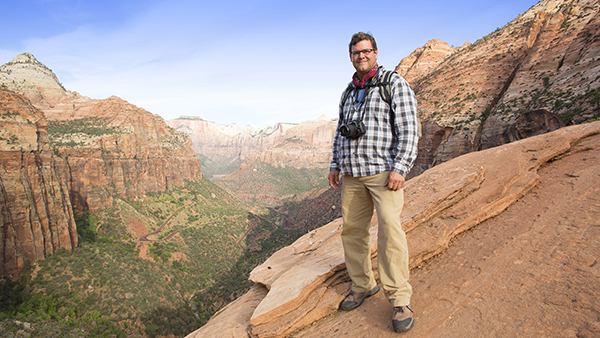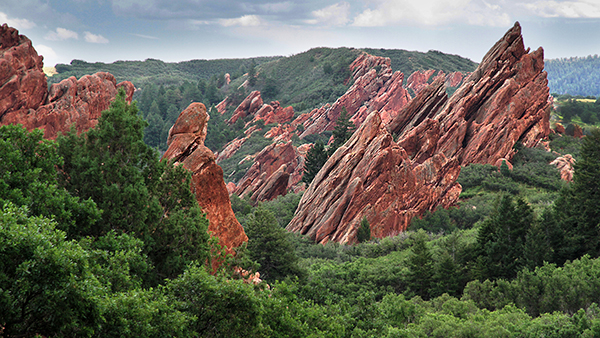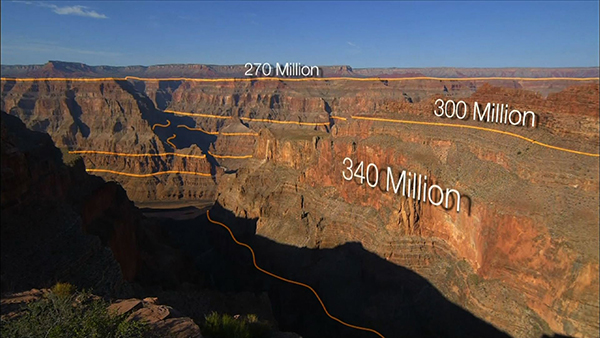
by Sara E. Pratt Tuesday, November 17, 2015

NOVA's Making North America is hosted by paleobotanist Kirk Johnson, director of the Smithsonian.
Geology isn’t often depicted in the popular media, and when it is, the coverage is often related to well-trodden topics like dinosaurs or natural disasters. So when I heard about the new three-hour-long documentary, “NOVA: Making North America,” I hoped for quality storytelling that touched on some of the other fascinating, though less-covered science in the field. The documentary, which has been airing over three consecutive weeks in November, purports to tell the geological, biological and anthropological story of North America. Unfortunately, it falls short on many counts.
Each episode begins with Kirk Johnson, a paleobotanist and the director of the Smithsonian Museum of Natural History in Washington, D.C., telling viewers, “I’m taking off on the field trip of a lifetime,” which he does. Johnson travels to more than a dozen states, leaping into one adventurous field experience after another. He rappels into the Grand Canyon in 100-degree heat, scuba-dives in the Bahamas, helicopters over a Hawaiian volcano, descends into a gold mine, hikes on a glacier, treks the badlands of North Dakota in search of dinosaur fossils and visits the famed La Brea tar pits where a multitude of ice-age remains have been uncovered. He even flies a drone over the red-rock flatirons on a Colorado golf course to explain the rise and fall of the Ancestral Rockies.

Johnson flies a drone over Arrowhead Golf Club located in Roxborough State Park just south of Denver to explore the Ancestral Rockies.
During all of these adventures his commentary contains many more utterances of “Wow!” and “Cool!” and “Oh, baby!” and “That’s crazy!” than one might expect from an eminent scientist, especially within a science documentary. Perhaps it was an attempt by Johnson, or his scriptwriters, to make geoscience seem cool or otherwise appeal to viewers with little or no science background, but it seemed somewhat contrived. While showing enthusiasm for geology is good — and more thorough scientific explanations of what we’re seeing and why it’s important are provided through interviews with other scientists — the show would have benefited from more discussion of the science from Johnson himself.
The show relies heavily on flashy graphics — including gridlines that spring from Johnson’s eyeglasses, like a heads-up display, indicating we are about to view a paleolandscape. Other graphics include three-dimensional renderings of the rock layers of the Grand Canyon, which pop from the cliff face and morph into the landscape in which they were deposited. For example, a sandstone layer slides out and becomes ancient desert dunes. A limestone layer deposited in an ocean is confusingly rendered as a cascading waterfall. Meanwhile, Johnson dangles from a rope against a rock layer that lies above the “ocean,” further adding to the confusion. The Grand Canyon animation concludes with multiple blocks simultaneously flying out into the airspace above the canyon, jumbling the paleoenvironments around in time and space. I suspect very few viewers came away from that with a clear understanding of the various sea-level transgressions and regressions that created the Grand Canyon’s past depositional environments.

The show relies heavily on computer-generated graphics, including an elaborate animation of the Grand Canyon's past depositional environments.
While many of the vignettes are interesting in and of themselves, the show jumps so abruptly from one to the next that it’s difficult to understand how the scenes are connected. Some periods of geologic time are covered extensively, while other long periods remain untouched. The show’s largest drawback is in failing to make these transitions and tell a cohesive story.
In one segment, the narration, which runs over footage of the 1989 Loma Prieta earthquake, says that gold concentrated in the mantle early in Earth’s history “hitches a ride on some kind of geological shake-up like an earthquake” to get back to the surface. Luckily, that dubious statement is clarified by Lisa White, a paleontologist at the University of California at Berkeley, who explains that earthquakes create fractures that act as conduits for the hydrothermal fluids from which gold-bearing quartz precipitates. But it’s a safe bet that at least some viewers now think earthquakes drive gold to the surface.
And that’s not the worst of it. Although the show is true to its tagline — “Host Kirk Johnson explores how the continent was shaped — and how it shaped us” — in a stunning omission, it neglects to discuss how we’re shaping it, even in the third and final episode, titled “Human,” which covers our interactions with the natural world.
But it’s not until three-quarters of the way through the episode that Johnson finally gets around to even mentioning climate change, perhaps the largest and most consequential human-planet interaction ever: “…we’re pumping oil and natural gas out of the ground at a record rate, which begs the question, ‘Should we?’ When we burn fossil fuel, the release of carbon dioxide causes Earth’s atmosphere and oceans to warm. As a result, glaciers are melting and sea levels are rising much faster than at the end of the last ice age.”
The press release promises that “NOVA touches on how overexploiting our natural resources could have serious consequences for North America’s future,” but it is a very, very light touch indeed. The entire climate-change segment (quoted above) lasts roughly 25 seconds. That’s about a quarter of the time Johnson spent visiting the old mint in San Francisco to stage a scene in which he opens a briefcase that emits a fake gold glow, like a special effect from an Indiana Jones movie, revealing a large gold nugget. And it’s seven-and-a-half times shorter than the segment on the construction of the transcontinental railroad, which only briefly mentions Sierra Nevada granite, but gives the host an opportunity to ride an antique coal-powered steam engine. (This isn’t the first time “NOVA” has been criticized about the dearth and quality of its climate-change coverage.)
Almost as surprising is the next line that Johnson delivers — a head-spinning transition from climate change to the seismic history of the Pacific Northwest’s Cascadia Subduction Zone and its potential to unleash a megaquake and tsunami: “Our impact on the planet is a huge concern, but as a geologist, I also worry about the nasty surprises our continent has in store for us.”
The series concludes with an animation of the continent’s tectonic future showing the plates drifting and merging into a new supercontinent, Pangea Ultima. It is perhaps an attempt to hint at the climate-change story missing from the narration. As the continents begin to drift, sea level rises rapidly, inundating most of the North American continent. Johnson closes the show by saying, “In geology, one thing is for sure, no landscape is permanent,” but with nary a mention of why viewers just saw much of North America drown.
Overall, the program is entertaining and the information presented in each vignette is mostly accurate. But the failure to tie it all together and tell the epic story that is North America’s geologic history was a sorely missed opportunity.
© 2008-2021. All rights reserved. Any copying, redistribution or retransmission of any of the contents of this service without the expressed written permission of the American Geosciences Institute is expressly prohibited. Click here for all copyright requests.